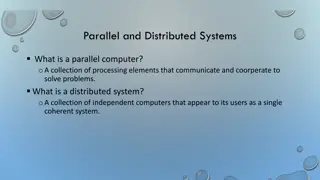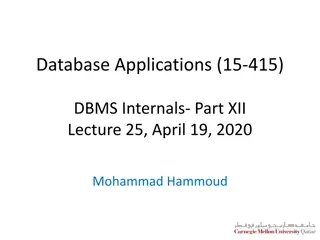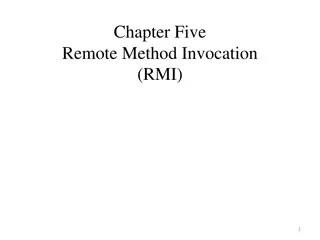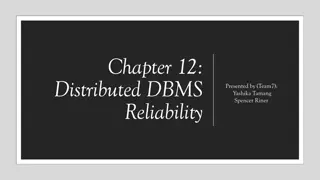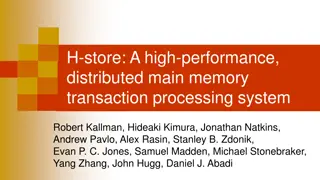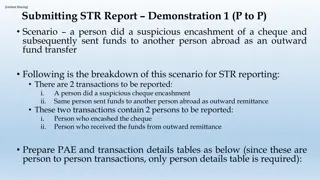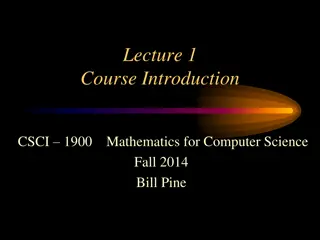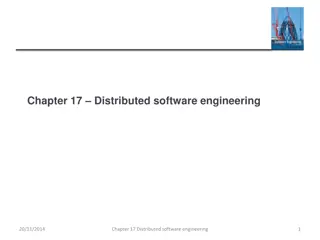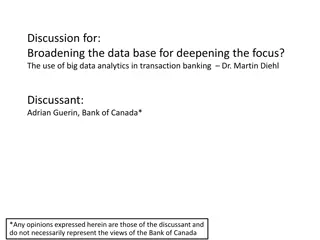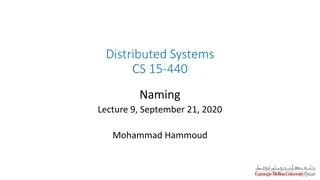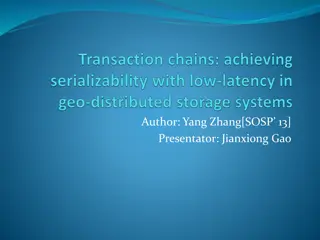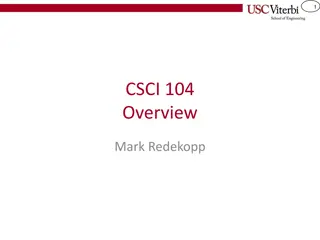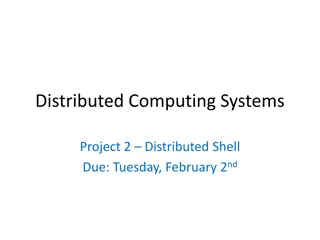Distributed Transaction Management in CSCI 5533 Course
Exploring transaction concepts and models in distributed systems, Team 5 comprising Dedeepya, Dodla, Ehtheshamuddin, and Hari Kishore under the guidance of Dr. Andrew Yang delve into the intricacies of distributed transaction management in CSCI 5533 Distributed Information Systems.
Download Presentation

Please find below an Image/Link to download the presentation.
The content on the website is provided AS IS for your information and personal use only. It may not be sold, licensed, or shared on other websites without obtaining consent from the author.If you encounter any issues during the download, it is possible that the publisher has removed the file from their server.
You are allowed to download the files provided on this website for personal or commercial use, subject to the condition that they are used lawfully. All files are the property of their respective owners.
The content on the website is provided AS IS for your information and personal use only. It may not be sold, licensed, or shared on other websites without obtaining consent from the author.
E N D
Presentation Transcript
1 Chapter 10 Distributed Transaction Management: Transaction Concepts & Models Team-5 Dedeepya, Dodla - 1813611 Ehtheshamuddin, Mohammed - 1766632 Hari Kishore, Thadisetti 1805237 Instructor: Dr. Andrew Yang Course: CSCI 5533 Distributed Information Systems
2 Contents What is Transaction Termination Conditions of Transactions Characterization of Transactions Formalization of the Transaction Concept Properties of Transaction Atomicity, Consistency, Isolation, Durability Types of Transactions Architecture Conclusion
Why Transactions? 3 The consistent execution or reliable computation in database systems is achieved through concept of Transactions. The queries are executed as transactions once their execution strategies are determined and they are translated into primitive database operations.
4 Transaction Consistency A database is in a consistent state if it obeys all the consistency (integrity) constraints defined over it. State changes occur due to modifications, insertions, and deletions (together called updates). A database can be temporarily inconsistent during execution of a transaction but should be consistent when transaction terminates. Transaction consistency, on the other hand, refers to the actions of concurrent transactions. A complication arises when replicated databases are considered. There are relaxed notions of replica consistency that allow replica values to diverge
5 Transaction Consistency
6 Transaction Reliability Reliability refers to both the resiliency of a system to various types of failures and its capability to recover from them. A resilient system is tolerant of system failures and can continue to provide services even when failures occur. A recoverable DBMS is one that can get to a consistent state (by moving back to a previous consistent state or forward to a new consistent state) following various types of failures.
7 A transaction takes a database, performs an action on it, and generates a new version of the database, causing a state transition. This is similar to what a query does, except that if the database was consistent before the execution of the transaction, we can now guarantee that it will be consistent at the end of its execution regardless of the facts that The transaction may have been executed concurrently with others Failures may have occurred during its execution Transaction is a single execution of a program [Ullman, 1988]. A single query can also be thought of as a program that can be posed as a transaction. Transactions in Distributed Systems
8 Example : Airline Reservation System Relation definition : FLIGHT(FNO, DATE, SRC, DEST, STSOLD, CAP) CUST(CNAME, ADDR, BAL) FC(FNO, DATE, CNAME, SPECIAL)
9 Example : Airline Reservation System Transaction in typical reservation system, where a travel agent enters the flight number, the date, and a customer name, and asks for a reservation. Begin_transaction Reservation begin input(flight no, date, customer name); EXEC SQL UPDATE FLIGHT SET STSOLD = STSOLD + 1 WHERE FNO = flight no AND DATE = date; EXEC SQL INSERT INTO FC(FNO,DATE,CNAME,SPECIAL) VALUES (flight no,date,customer name, null); output( reservation completed ) end.
Termination Conditions of Transactions 10 A transaction always terminates, even when there are failures If the transaction can complete its task successfully, we say that the transaction commits. If, on the other hand, a transaction stops without completing its task, we say that it aborts. Transactions may abort for several reasons Additionally, the DBMS may abort a transaction due to, for example, deadlocks or other conditions.
Rollback and Commit 11 Rollback : When a transaction is aborted, its execution is stopped and all of its already executed actions are undone by returning the database to the state before their execution. Commit : The importance of commit is twofold. The commit command signals to the DBMS that the effects of that transaction should now be reflected in the database, thereby making it visible to other transactions that may access the same data items. Second, the point at which a transaction is committed is a point of no return. The results of the committed transaction are permanently stored in the database and cannot be undone.
12 Example : Termination Let us return to our reservation system example. One thing we did not consider is that there may not be any free seats available on the desired flight. To cover this possibility, the reservation transaction needs to be revised as follows Begin_transaction Reservation begin input(flight no, date, customer name); EXEC SQL SELECT STSOLD,CAP INTO temp1,temp2 FROM FLIGHT WHERE FNO = flight no AND DATE = date;
13 Example : Termination end. if temp1 = temp2 then begin output( no free seats ); Abort end elsebegin EXEC SQL UPDATE FLIGHT SET STSOLD = STSOLD + 1 WHERE FNO = flight no AND DATE = date; EXEC SQL INSERT INTO FC(FNO,DATE,CNAME,SPECIAL) VALUES (flight no, date, customer name, null); Commit; output( reservation completed ) end end-if
14 Example : Termination What is covered in this example : If no free seats are available, the transaction is aborted Ordering of the output to the user with respect to the abort and commit commands. Transactions can be aborted either due to application logic, as is the case here, or due to deadlocks or system failures. If the transaction is aborted, the user can be notified before the DBMS is instructed to abort it. However, in case of commit, the user notification has to follow the successful servicing (by the DBMS) of the commit command, for reliability reasons
Characterization of Transactions 15 Transactions are characterized only based on their read and write operations, without considering the insertion and deletion operations The data items that a transaction reads are said to constitute its read set (RS). Similarly, the data items that a transaction writes are said to constitute its write set (WS). The read set and write set of a transaction need not be mutually exclusive. The union of the read set and write set of a transaction constitutes its base set (BS = RS[WS).
16 Example : Characterization RS[Reservation] = fFLIGHT.STSOLD, FLIGHT.CAPg WS[Reservation] = fFLIGHT.STSOLD, FC.FNO, FC.DATE, FC.CNAME, FC.SPECIALg BS[Reservation] = fFLIGHT.STSOLD, FLIGHT.CAP, FC.FNO, FC.DATE, FC.CNAME, FC.SPECIALg
Formalization of the Transactions 17 The meaning of a transaction should be intuitively clear. To reason about transactions and about the correctness of the management algorithms, it is necessary to define the concept formally. We use the following notation: Ti be a transaction and x be a relation or a data item of a relation Oi j(x) some operation Oj of transaction preceding section, Oi j E{read, write} OSi denote the set of all operations in Ti (i.e., OSi = Uj O ij) Ni {A,C} is the termination operation, i.e.,abort/commit
18 Formalization of the Transactions
19 The first condition formally defines the domain as the set of read and write operations that make up the transaction, plus the termination condition, which may be either commit or abort. Formalization of the Transactions The second condition specifies the ordering relation between the conflicting read and write operations of the transaction. The final condition indicates that the termination condition always follows all other operations.
20 Example : Formalization
21 Formalization : DAG (Directed Acyclic Graph One advantage of defining a transaction as a partial order is its correspondence to a directed acyclic graph (DAG). Thus a transaction can be specified as a DAG whose vertices are the operations of a transaction and whose arcs indicate the ordering relationship between a given pair of operations. DAG will be useful in discussing the concurrent execution of several transactions and in arguing about their correctness by means of graph-theoretic tools.
Properties of Transaction 22 Atomicity Consistency Isolation Durability The consistency and reliability aspects of transactions are due to four properties Together, these are commonly referred to as the ACID properties of transactions. They are not entirely independent of each other; usually there are dependencies among them.
23 Atomicity refers to the fact that a transaction is treated as a unit of operation. Therefore, either all the transaction s actions are completed, or none of them are. This is also known as the all-or- nothing property. Atomicity In general there can be two types of failures. A transaction itself may fail due to input data errors, deadlocks, or other factors. In these cases either the transaction aborts itself, or the DBMS may abort it while handling deadlocks, for example. Maintaining transaction atomicity in the presence of this type of failure is commonly called the transaction recovery
24 Failure is caused by system crashes, such as media failures, processor failures, communication link breakages, power outages, and so on. Ensuring transaction atomicity in the presence of system crashes is called crash recovery. Atomicity (Contd..) An important difference between the two types of failures is that during some types of system crashes, the information in volatile storage may be lost or inaccessible. Both types of recovery are parts of the reliability issue
25 The consistency of a transaction is simply its correctness. Dirty data refers to data values that have been updated by a transaction prior to its commitment. Then, based on the concept of dirty data, the four levels of consistency are defined as follows Degree 3: Transaction T sees degree 3 consistency if: Consistency T does not overwrite dirty data of other transactions. T does not commit any writes until it completes all its writes [i.e., until the end of transaction (EOT)]. T does not read dirty data from other transactions. Other transactions do not dirty any data read by T before T completes.
26 Degree 2: Transaction T sees degree 2 consistency if: T does not overwrite dirty data of other transactions. T does not commit any writes before EOT. Consistency (Contd..) T does not read dirty data from other transactions. Degree 1: Transaction T sees degree 1 consistency if: T does not overwrite dirty data of other transactions. T does not commit any writes before EOT.
27 Degree 0: Transaction T sees degree 0 consistency if: T does not overwrite dirty data of other transactions. Consistency (Contd..) Of course, it is true that a higher degree of consistency encompasses all the lower degrees. The point in defining multiple levels of consistency is to provide application programmers the flexibility to define transactions that operate at different levels. Consequently, while some transactions operate at Degree 3 consistency level, others may operate at lower levels and may see, for example, dirty data.
28 Isolation is the property of transactions that requires each transaction to see a consistent database always. Isolation In other words, an executing transaction cannot reveal it results to other concurrent transactions before its commitment.
29 Example : Isolation Consider the following two concurrent transactions (T1 and T2), both of which access data item x. Assume that the value of x before they start executing is 50.
30 Example : Isolation In this case there are no problems; transactions T1 and T2 are executed one after the other and transaction T2 reads 51 as the value of x. Note that if, instead, T2 executes before T1, T2 reads 51 as the value of x. So, if T1 and T2 are executed one after the other (regardless of the order), the second transaction will read 51 as the value of x and x will have 52 as its value at the end of execution of these two transactions.
31 Example : Isolation However, since transactions are executing concurrently, the following execution sequence is also possible T1: x x+1 T2: Read(x) T1: Write(x) T2: x x+1 T2: Write(x) T1: Commit T2: Commit In this case, transaction T2 reads 50 as the value of x. This is incorrect since T2 reads x while its value is being changed from 50 to 51. Furthermore, the value of x is 51 at the end of execution of T1 and T2 since T2 s Write will overwrite T1 s Write.
32 As we move up the hierarchy of consistency levels, there is more isolation among transactions. Degree 0 provides very little isolation other than preventing lost updates. However, since transactions commit write operations before the entire transaction is completed (and committed), if an abort occurs after some writes are committed to disk, the updates to data items that have been committed will need to be undone. Since at this level other transactions are allowed to read the dirty data, it may be necessary to abort them as well. Degree 2 consistency avoids cascading aborts Degree 3 provides full isolation which forces one of the conflicting transactions to wait until the other one terminates Isolation (Contd..)
33 Durability refers to that property of transactions which ensures that once a transaction commits, its results are permanent and cannot be erased from the database. Therefore, the DBMS ensures that the results of a transaction will survive subsequent system failures. Durability The durability property brings forth the issue of database recovery, that is, how to recover the database to a consistent state where all the committed actions are reflected
Types of Transactions 34 Transactions have been classified according to several criteria. One criterion is the duration of transactions. Accordingly, transactions may be classified as online or batch [Gray, 1987]. These two classes are also called short-life and long-life transactions, respectively Another classification that has been proposed is with respect to the organization of the read and write actions. The examples that we have considered so far intermix their read and write actions without any specific ordering. We call this type of transactions general.
Types of Transactions 35 If the transactions are restricted so that all the read actions are performed before any write action, the transaction is called a two-step transaction [Papadimitriou, 1979]. If the transaction is restricted so that a data item has to be read before it can be updated (written), the corresponding class is called restricted (or read-before-write) [Stearns et al., 1976]. If a transaction is both twostep and restricted, it is called a restricted two- step transaction Finally, there is the action model of transactions [Kung and Papadimitriou, 1979], which consists of the restricted class with the further restriction that each [read, write] pair be executed atomically
36 Examples The following are some examples of the above-mentioned models. We omit the declaration and commit commands. General: T1 : fR(x);R(y);W(y);R(z);W(x);W(z);W(w);Cg Two-step: T2 : fR(x);R(y);R(z);W(x);W(z);W(y);W(w);Cg Restricted: T3 : fR(x);R(y);W(y);R(z);W(x);W(z);R(w);W(w);Cg Note that T3 has to read w before writing.
37 Examples Two-step restricted: T4 : fR(x);R(y);R(z);R(w);W(x);W(z);W(y);W(w);Cg Action: T5 : f[R(x);W(x)]; [R(y);W(y)]; [R(z);W(z)]; [R(w);W(w)];Cg Note that each pair of actions within square brackets is executed atomically.
38 Example
39 Types Flat Transactions Flat transactions have a single start point (Begin transaction) and a single termination point (End transaction). Most of the transaction management work in databases has concentrated on flat transactions.
40 Types Nested Transactions An alternative transaction model is to permit a transaction to include other transactions with their own begin and commit points. Such transactions are called nested transactions. These transactions that are embedded in another one are usually called sub transactions.
41 Example Nested Transactions Let us extend the reservation transaction. Most travel agents will make reservations for hotels and car rentals in addition to the flights. If one chooses to specify all of this as one transaction, the reservation transaction would have the following structure: Begin transaction Reservation begin Begin transaction Airline : : : end. fAirlineg Begin transaction Hotel : : : end. fHotelg Begin transaction Car : : : end. fCarg end
42 Types Nested Transactions (Contd..) Nested transactions have received considerable interest as a more generalized transaction concept. The level of nesting is generally open, allowing sub transactions themselves to have nested transactions. This generality is necessary to support application areas where transactions are more complex than in traditional data processing.
43 Advantages Nested Transactions The advantages of nested transactions are the following. 1. First, they provide a higher-level of concurrency among transactions. Since a transaction consists of a number of other transactions, more concurrency is possible within a single transaction. 2. It is possible to create new transactions from existing ones simply by inserting the old one inside the new one as a sub transaction.
44 For example, if the reservation transaction of is implemented as a flat transaction, it may not be possible to access records about a specific flight concurrently. In other words, if one travel agent issues the reservation transaction for a given flight, any concurrent transaction that wishes to access the same flight data will have to wait until the termination of the first, which includes the hotel and car reservation activities in addition to flight reservation. However, a nested implementation will permit the second transaction to access the flight data as soon as the Airline sub transaction of the first reservation transaction is completed. In other words, it may be possible to perform a finer level of synchronization among concurrent transactions. Types Nested Transactions (Contd..)
45 The term workflow, unfortunately, does not have a clear and uniformly accepted meaning. Types Workflow A working definition is that a workflow is a collection of tasks organized to accomplish some business process.
46 Three types of workflows are identified: 1. Human-oriented workflows: Involve humans in performing the tasks. The system support is provided to facilitate collaboration and coordination among humans, but it is the humans themselves who are ultimately responsible for the consistency of the actions. 2. System-oriented workflows: Are those that consist of computation-intensive and specialized tasks that can be executed by a computer. The system support in this case is substantial and involves concurrency control and recovery, automatic task execution, notification, etc. 3. Transactional workflows: Range in between human- oriented and system-oriented workflows and borrow characteristics from both. They involve coordinated execution of multiple tasks that (a) may involve humans, (b) require access to HAD [heterogeneous, autonomous, and/or distributed] systems, and (c) support selective use of transactional properties [i.e., ACID properties] for individual tasks or entire workflows. [Georgakopoulos et al., 1995]. Among the features of transactional workflows, the selective use of transactional properties is particularly important as it characterizes possible relaxations of ACID properties. Types Workflow (Contd..)
47 Architecture The distributed execution monitor consists of two modules: a transaction manager (TM) and a scheduler (SC). The transaction manager is responsible for coordinating the execution of the database operations on behalf of an application. The scheduler is responsible for the implementation of a specific concurrency control algorithm for synchronizing access to the database.
Architecture (Contd..) 48 A third component that participates in the management of distributed transactions is the local recovery managers (LRM) that exist at each site. Their function is to implement the local procedures by which the local database can be recovered to a consistent state following a failure. Each transaction originates at one site, which we will call its originating site. The execution of the database operations of a transaction is coordinated by the TM at that transaction s originating site.
Architecture (Contd..) 49 The transaction managers implement an interface for the application programs which consists of five commands: Begin transaction Read Write Commit Abort. The processing of each of these commands in a non-replicated distributed DBMS is discussed below at an abstract level. For simplicity, we ignore the scheduling of concurrent transactions as well as the details of how data is physically retrieved by the data processor.
Architecture (Contd..) 50 1. Begin transaction : This is an indicator to the TM that a new transaction is starting. The TM does some bookkeeping, such as recording the transaction s name, the originating application, and so on, in coordination with the data processor. 2. Read : If the data item to be read is stored locally, its value is read and returned to the transaction. Otherwise, the TM finds where the data item is stored and requests its value to be returned (after appropriate concurrency control measures are taken). 3. Write : If the data item is stored locally, its value is updated (in coordination with the data processor). Otherwise, the TM finds where the data item is located and requests the update to be carried out at that site after appropriate concurrency control measures are taken). 4. Commit : The TM coordinates the sites involved in updating data items on behalf of this transaction so that the updates are made permanent at every site. 5. Abort : The TM makes sure that no effects of the transaction are reflected in any of the databases at the sites where it updated data items.





